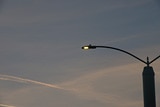- City populations grow by 7,500 people per hour and mobile data traffic is expected to grow ten times by 2019, increasing the need for sustainable lighting and enhanced mobile capacity and coverage in cities
- New connected street lighting model solves two issues simultaneously: offering city officials an innovative way to afford next generation energy efficient LED lighting to meet sustainability goals, and enabling network operators to offer improved city-wide mobile broadband and app coverage
- Called “Zero Site” by Ericsson, connected lighting solution integrates telecom equipment into light poles enabling telecom operators to improve mobile network performance while reducing urban clutter
- Citizens will benefit from improved mobile network coverage for data communications and enhanced safety with brighter, well lit streets
Mobile World Congress, Barcelona, Spain - Royal Philips (NYSE: PHG, AEX: PHIA), the global leader in lighting, and Ericsson (NASDAQ:ERIC) have jointly launched an innovative new connected LED street lighting model. The partnership solves two major issues that cities are facing today: providing citizens with improved network performance in dense urban areas as well as high quality, public lighting that is energy efficient.
Philips and Ericsson combine the benefits of mobile connectivity and LED lighting in a ‘’lighting-as-a-service’’ model for cities. It allows city authorities to offer space within their connected lighting poles to network service providers for mobile broadband infrastructure.
Philips will now offer cities LED street lighting that can include mobile telecoms equipment from Ericsson. Mobile operators working with Ericsson for mobile broadband infrastructure will be able to rent space in the poles. In this way, mobile network operators will be able to improve data coverage and capacity for citizens, resulting in enhanced mobile broadband services. The model also accelerates the payback time for city infrastructure, by making the up-front costs of installing and managing these systems more affordable, so reducing the strain on city budgets.
Philips LED street lighting can generate energy savings of 50 to 70 percent, with savings reaching 80 percent when coupled with smart controls – as validated by a study conducted by The Climate Group in 12 of the world’s largest cities. The study also showed that citizens prefer the white light of LED lighting, citing a greater sense of safety and improved visibility compared to the orange glow of traditional high pressure sodium systems.
Ericsson President and CEO Hans Vestberg says: “This is a tremendous solution using ICT and partnerships to address the megatrend of urbanization. City populations are increasing at the rate of 7,500 people per hour, but our world is not geographically expanding. Meanwhile, our ConsumerLab research shows that internet connectivity is one of the top five factors for satisfaction in city life. This Zero Site solution is the kind of innovation that offers a way for people to succeed in the Networked Society.”
Frans van Houten, President and CEO of Philips, says: “This new connected LED street lighting model is another example of us bringing the Internet of Things to life and demonstrates the capabilities of light beyond illumination. We are offering lighting as a service that scales with a city’s needs and enables city officials to offer their citizens a more connected, energy efficient and safer urban environment, while preserving existing budgets and resources to improve the livability of their city.”
To meet the demand for coverage and capacity, mobile operators need to improve, densify and add many more radio cell sites in dense areas. The new connected street light pole, designed to house Ericsson’s cutting edge suite of small cell products, offers network operators new possibilities to find the right site location. It will also help to scale the deployment of mobile broadband technology beyond traditional sites – a key enabler for evolving heterogeneous networks.



